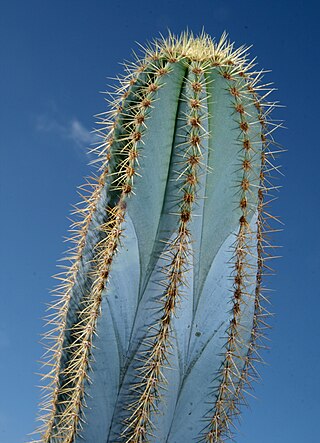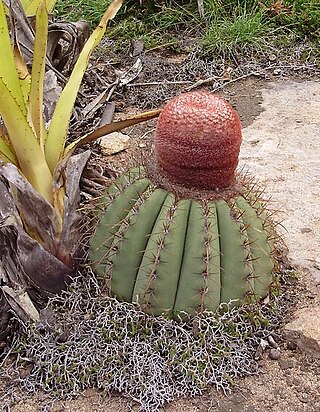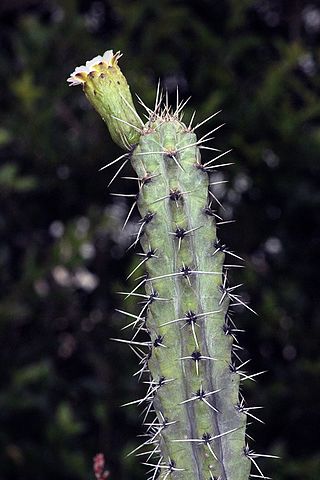
Pilosocereus floccosus is a species of plant in the family Cactaceae. It is endemic to Brazil, in Bahia and Minas Gerais states. Its natural habitats are subtropical or tropical dry forests and rocky areas. It is threatened by habitat loss.

Pilosocereus magnificus is a species of plant in the family Cactaceae. It is endemic to Brazil, within Minas Gerais state. Its natural habitats are subtropical or tropical dry forests, subtropical or tropical dry shrubland, and rocky areas. It is threatened by habitat loss.

Pilosocereus multicostatus is a species of plant in the family Cactaceae. It is endemic to Brazil, in northern Minas Gerais state. Its natural habitat are rocky areas. It is threatened by habitat loss.

Strophocactus brasiliensis, synonym Pseudoacanthocereus brasiliensis, is a species of plant in the family Cactaceae. It is endemic to Brazil. Its natural habitats are subtropical or tropical dry forests and hot deserts. It is threatened by habitat loss.

Schlumbergera opuntioides is a species of plant in the family Cactaceae. It is endemic to the coastal mountains of south-eastern Brazil where its natural habitats are humid forests and rocky areas. It is threatened by habitat loss. It is in the same genus as the popular house plant known as Christmas Cactus or Thanksgiving Cactus.

Tacinga braunii is a species of plant in the family Cactaceae. It is endemic to Eastern Brazil where its distribution is restricted to the north-eastern region of Minas Gerais in the valley of the river Jequitinhonha, where it grows on gneiss or granite rock outcrops. It is pollinated by hummingbirds. Its natural habitats are subtropical or tropical dry forests and hot deserts. It is threatened by habitat loss.

Uebelmannia gummifera is a species of plant in the family Cactaceae. It is endemic to Brazil. Its natural habitat is dry savanna. It is threatened by habitat loss.

Pilosocereus royenii is a species of cactus found throughout the West Indies and the states of Yucatán and Quintana Roo in Mexico. Common names include Royen's tree cactus, dildo cactus, and pipe organ cactus. It is composed of multiple long, tubular shaped branches, each ribbed with multiple sections and sharp spines.

Pereskia aculeata is a scrambling shrub in the family Cactaceae. Common names include Barbados gooseberry, blade-apple cactus, leaf cactus, rose cactus, and lemonvine. It is native to tropical America. The leaves and fruits are edible, containing high quantities of protein, iron and other nutrients, and it is a popular vegetable in parts of the Brazilian state of Minas Gerais under the name of ora-pro-nóbis.

Pilosocereus robinii is a species of cactus known by the common name Key tree-cactus. It is native to the Florida Keys in the United States. It also occurs in Western Cuba and the Northern Bahamas. It has been erroneously reported from Puerto Rico, the Virgin Islands, and Mexico. It is a rare species which is threatened by the loss of its habitat. It is a federally listed endangered species of the United States.

Cereus jamacaru, known as mandacaru or cardeiro, is a cactus native to central and eastern Brazil. It often grows up to 6 metres high.

Hatiora cylindrica is a species of often epiphytic cactus in the tribe Rhipsalideae within the subfamily Cactoideae. It is native to east Brazil, where it grows in a variety of habitats, including moist forest, dunes and coastal rocks.

Mirabella estevesii, synonym Cereus estevesii, is a species of columnar cactus found in Minas Gerais, Brazil. The first description was published in 2004 by Pierre Josef Braun as Cereus estevesii.

Pilosocereus leucocephalus, called old man cactus, old man of Mexico, tuno, and woolly torch, is a species of cactus in the genus Pilosocereus, native to Mexico and Central America. It has gained the Royal Horticultural Society's Award of Garden Merit. Pilosocereus leucocephalus functions as a keystone species in dry landscapes found in Mesoamerica. The fruit this cactus produces is relied upon as a source of hydration and sugar in arid areas by frugivores such as birds, bats, and even some reptiles.

Pilosocereus machrisii is a species of Pilosocereus found in from West Bahia to Minas Gerais, Brazil.

Melocactus ernesti is one of the Turk's cap cacti, and is native to Bahia and Minas Gerais States, Brazil.

Xiquexique is genus of cactus from Brazil.

Xiquexique tuberculatus is a plant species in the genus Xiquexique from the cactus family. It is commonly called "Caxacubri".

Melocactus bahiensis is a species of Melocactus found in Bahia, Brazil.

Cipocereus crassisepalus is a species of cactus endemic to the state of Minas Gerais in Brazil.





















